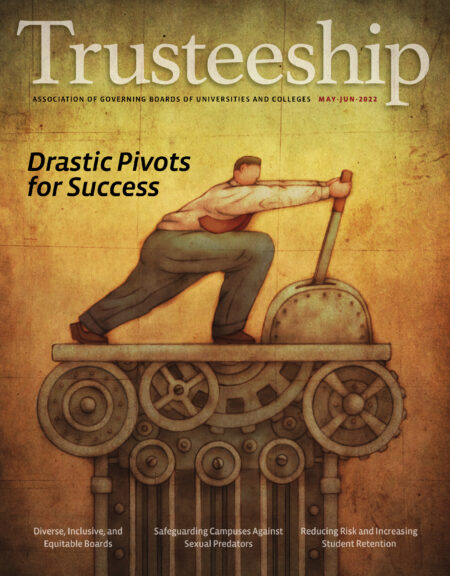
- As leaders who set the tone (along with the president and staff) and serve as a source of power and influence, trustees’ engagement in advancing DEI initiatives is critical to fulfilling the institution’s mission. These issues matter to current and prospective students, parents, faculty, donors, accrediting bodies, and the communities surrounding the campus.
- Trustees must examine their personal feelings about these issues in tandem with the overall board’s reflections. Advancing board engagement means working at the individual, committee, and board levels.
- At the board level, it is essential to gain an understanding of the board’s culture and how it is experienced by individuals. Just because many trustees are alums of the institution does not mean they all had the same experience as students; the same is true with individuals’ service on the board.
- To achieve some relatively quick victories, grab some low-hanging fruit by recognizing and removing structural barriers, as idea number 12 suggests.
Introduction
In Part I of this series (see the March/April issue of Trusteeship) I outlined numerous reasons why—despite goodwill and good intentions—progress has been slow with respect to increasing board diversity and engaging trustees—as individuals and as a collective— in examining their own beliefs and the board’s culture regarding diversity, inclusion, and equity. Those reasons include: (1) the need for individual commitment; (2) group dynamics; (3) structural issues; (4) inertia; and (5) mindsets and metrics.
In this article, I offer a dozen ideas and strategies for confronting and overcoming roadblocks to encourage progress toward a diverse, inclusive, and equitable board. Importantly, there is no panacea or single solution. In fact, wanting a silver bullet or fast solution is one of the barriers to making progress.
Editor’s Note: This is the second in a two-part series focused on boards’ engagement with diversity, equity, and inclusion (DEI).
1. Ensure Authentic Leadership
We all know nothing much happens without leadership and ensuring diverse, inclusive, and equitable boards is no different. In fact, leaders on these issues need to exemplify what is being asked of others: authenticity, curiosity, humility, vulnerability, courage, introspection, and self-awareness, to name a few characteristics. Because they set the tone, the president and board chair must visibly support this work. And it is helpful to have a task force, ad hoc group, or steering committee of trustees working on these matters. That group should start by writing a charge (or vision statement) that clearly articulates the goals and outcomes desired for the par- ticular board. This group will need to ensure that the rest of the board understands that these efforts require “all hands on deck”—not just those trustees already so inclined and passionate about advancing these issues. DEI is just like the annual fund or the capital campaign—all trustees must contribute.
2. Articulate Why
Simon Sinek’s much viewed “Start with Why” Ted Talk and best-selling book pres- ent a “golden circle” that poses three ques- tions for every enterprise. These include two process questions—what and how?— and one purpose question—why? The why is in the center of the circle because inspiration comes from answering why, not focusing on what or how. For board engagement in DEI initiatives, answering several “whys” includes:
- Making a comprehensive case for DEI. The business case is relatively easy to make and should be articulated, but Rodney Patterson, CEO of The Learner’s Group, reminds us that there are five other cases to be made: academic, legal, social justice, equitable, and religious (https://thelearnersgroup.com/blog/f/making-the-full-case-for-diversity-in-higher-education). I would add yet another—the philanthropic case, as your student population is increasingly diverse and thus so will be your alumni and your future donors.
- Fulfilling the institutional mission. There is a virtuous cycle when boards engage in DEI matters that moves from more attuned and equipped trustees to an improved governing body to making the institution ever better.
- Walking the talk. Because of its visibility at the apex of leadership, the board must do more than pay lip service to DEI matters. Ideally, the board values DEI, the board itself is diverse, and trustees themselves engage in an inclusive manner in their work. The board sets the tone and leads by example.
- Responding to a new Carnegie Classification. The Chronicle of Higher Education (Mangan, February 9, 2022; https://www.chronicle.com/article/new-carnegie-classification-will-reflect-social- and-economic-mobility) reported that, in an effort to create incentives for colleges to eliminate gaps in equity, beginning in 2023 the Carnegie Classification group will add a new distinction to which campuses can aspire: a category that reflects how well they contribute to social and economic mobility while serving diverse students.
- Responding to the College Transparency Act (CTA). In early February, the U.S. House of Representatives approved the CTA as an amendment to the America COMPETES Act. At the time of this writing, the act is awaiting Senate approval. According to Diverse Issus in Higher Ed, “The CTA would gather more comprehensive student data, including by race, to better identify inequities and close those gaps” (Kelliher, February 10, 2022, https://www. diverseeducation.com/leadership-policy/ article/15288355/what-the-college- transparency-act-may-mean-for-higher-ed).
What may lie ahead? Once called the watchdogs that ”rarely bite” (The Wall Street Journal, June 17, 2015, https://www.wsj.com/articles/the-watchdogs-of-college-education-rarely-bite-1434594602), it is only a matter of time before college and university regional accrediting bodies use student outcomes in reaccreditation guidelines and expectations. Best to be prepared.
3. Start With Something Easy/Nonthreatening
There can be a tendency in the boardroom to focus on routine matters and on areas that are the professional (and therefore comfortable) milieu of trustees, such as finance, investments, and the endowment or on other topics that are of personal interest such as athletics. Discussing DEI can feel risky because of personal feelings and experiences, ambiguity, lack of expertise—issues mentioned in Part I of this series. So trustees might warm up by engaging the board in dialogue around the budget and the norms that the institution could revise to support DEI, using as a case study the Feb 2, 2022, Inside Higher Ed opinion piece by Fhagen and Muñoz (https://www.insidehighered.com/views/2022/02/02/six-budget-norms-colleges-should-revise-support-dei-opinion). Ask trustees, “What are some of our budget process norms and assumptions? What has become routine and therefore goes unquestioned? What if we approached the budgeting process with a DEI lens?” Or use that opinion piece to prompt trustees to unpack a different area of board oversight that may have entrenched routines that have gone unexamined for their impact on DEI.
4. Ask Better Questions
Hildy Gottlieb, a social-change theorist and co-founder of Change the Future, in “Creating a Better World Means Asking Better Questions” (Stanford Social Innovation Review, Jul 24, 2020) reminds of us the power of great questions to change thinking in ways that can lead to different actions and results. Questions such as, “What is the problem and how will we react to it?” reveal only a narrow slice of reality. The focus is on the past and on the problem rather than opening up people’s thinking to new possibilities. Some questions can immediately put trustees on the defensive such as, “Why do you think our board lacks racial diversity? Why do we have so few women on the board? Does it feel like there is an in-group and an out-group on our board?” Instead, ask questions like these: “What adjectives describe the board’s culture presently? What adjectives would you like to use to describe the culture? Looking at the board’s culture through a DEI lens, what do you see? What would a diverse, equitable, and inclusive board culture enable?” To ensure candor, and not judgment, allow trustees to answer anonymously and then discuss the responses.
Thinking about board composition, a typical question asked by governance or trusteeship committees is, “What skills and expertise do we need on the board?” A better question is, “Who do we need to be as a leadership body to earn the trust, confidence, and respect of those we seek to partner with and serve?” (Jim Taylor, Blue Avocado Webinar “The Four Principles of Purpose-Driven Board Leadership, Nov 2, 2021).
5. Provide a Roadmap (of sorts)
As they embark on their DEI journey, trustees want to know where they are headed. To the extent possible, try to sketch that out, along with goals, activities, and a timeframe. Be clear that a precise roadmap cannot be drawn because such journeys are not linear and are ongoing; there is no clear “stopping” point or final destination. But there are destinations (goals) and activities (between and at board meetings) along the way.
6. Be Intentional about Building a Diverse Boards
A good practice is to create a matrix listing the demographics (e.g., age, race, gender, relationship to the institution, geographic location) and types of expertise (e.g., higher education, finance, real estate, legal, technology, arts, healthcare) that interest boards. Go a step further and think about skillsets (e.g., leadership, team player, listener, synthesizer, emotional intelligence); competencies (e.g., diplomacy, curiosity, adaptability, humility, openness); and mindsets (analytical, entrepreneurial, strategic, process-oriented, task-oriented, relational) and then add some that are most relevant for serving as a trustee at your institution. Next, plot your current trustees onto the matrix, including their terms of service and term limits, so you know which trustees will retire from the board and when. This can help you see into the future as you develop broad and deep pools of trustee prospects. A matrix approach also helps you see multiple important characteristics of each trustee (e.g., black woman entrepreneur with experience as an attorney). Another benefit is that you will think more critically about what trustees bring to bear in the boardroom and consider that a trustee’s impact is more than simply their area of expertise.
7. Measure and Discuss Board Culture
Colleague Peter Eckel and I designed a Board Culture Profile (akin to the Myers-Briggs© Personality Indicator) that measures and places along a continuum several key dimensions of a board’s culture, including patterns of influence (consolidated—distributed), decision-making preferences (convergence—divergence), mindset (corporate—academic), and perception of primary role (challenger—supporter). There are also comportment measures such as trust, respect, and candor. The survey was designed to help boards see and understand elements of their culture that members may not even be aware of. And because the instrument captures gender, race, tenure as a trustee, and whether the respondent holds a leadership position (e.g., officer or committee chair and/or service on a powerful Executive Committee), boards can discern how the culture may be experienced differently depending on those variables. By making culture visible, changing it becomes possible
8. Develop DEI Definitions that Work for the Board
Many institutions have defined diversity, equity, and inclusion for their campus and such definitions typically “live” on the website and in the strategic plan. The issue is that most boards either have not discussed what those terms mean for the board or the board does not find them compelling for members themselves. Discussing their meaning for the board can be an important exercise for trustees as they begin to work on these matters. While determining definitions together can build bonds, it is essential not to get so bogged down in defining terms that nothing happens or that some trustees become frustrated and tune out.
9. Ensure Work at All Levels: Individual, Committee, Board
Individual. As noted in Part I, DEI is not like other topics (e.g., finance, investments, endowment growth) where (a) some trustees have expertise and others do not; (b) the board can rely on the particular expertise of certain members to oversee related matters appropriately; and (c) some trustees can fully engage on the topics at meetings and others cannot. Success necessitates that every trustee be personally committed to DEI learning and growth, which requires that individuals work on themselves between meetings and do the DEI homework associated with meetings. One idea is to ask each trustee to write a personal “DEI commitment statement” (see box).
I will:
- Do the DEI homework associated with meetings
- Engage openly and honestly with trustee and staff colleagues
- Embrace challenging conversations
- Be vulnerable
- Assume colleagues’ positive and productive intent
- Listen carefully to others to understand their story and their views
- Be self-aware
- Get to know all trustees; spend time with those I don’t know well
- Be curious—ask questions
Committee. It is essential that matters of diversity, equity, and inclusion permeate committee meetings. Some boards have a des- ignated advocate or point person on each committee whose job it is to ensure that a DEI lens is brought to the table, that committee conversations are inclusive, and that thoughtful questions from a DEI perspective are posed.
Full board. Just as every board meeting focuses trustees’ atten- tion on financial matters, enrollment, campus plans, and strategic direction, there should be activities and discussions around DEI themes, campus life, and the faculty and student experience. At the outset, and until DEI becomes embedded in the board’s culture, you may need to explicitly note DEI topics and activities on the agenda. As with individual trustees’ “I will” statements, you may want to develop some “As a board, we will …” statements (see box).
We will:
- Stay focused on DEI engagement for the board
- Be group-aware
- Engage thoughtfully and openly as a governing body
- Build an inclusive culture
- Develop benchmarks and goals
- Hold ourselves (not just management) accountable for DEI progress
- Celebrate milestones
Concerning racial matters, consider some of the excellent ideas suggested by Shaun Harper (“Racial Tensions Between Presidents and Governing Boards,” Trusteeship, Mar/Apr 2021, Vol 29, Num- ber 2). With the president, (1) acknowledge that racial tensions exist; (2) educate trustees on a variety of racial equity topics; (3) carefully examine data from campus racial climate surveys to gain a fuller understanding of the institution; and (4) revisit lists of demands issued by student activists and their allies.
10. Suggest Readings and Videos to Stimulate Introspective and Personal Growth
Share ideas for learning and personal growth with trustees— some that they could do on their own and some for conversation together over a meal at a meeting. There is no shortage of videos, books, and articles about DEI in higher education and for non- profit as well as corporate boards. Get trustees reading. Some books I have found particularly helpful include White Fragility (Di Angelo, 2018); Biased (Eberhardt, 2019); Talking to Strangers (Gladwell, 2019); Privilege, Power, and Difference (Johnson, 2018); and The Sum of Us (Heather McGhee, 2021). Encourage trustees to do their own searches and discover videos and articles they find illuminating that could be fodder for board discussion. Ask interested trustees to lead a short discussion session with the board focused on a shared reading or video.
Get trustees thinking about their own biases—conscious and unconscious—and ways to confront them. One tool that I know many have found helpful is the Implicit Association Test, which is a Harvard-designed resource to help individuals uncover unconscious biases within their own minds (spoiler alert: we all have them).
11. Provide Safe and Brave Spaces for DEI Dialogue at Meetings, with Ground Rules
- Provide safe and brave spaces. I cannot say how best to approach these concepts with your board, but the distinction between the two is worthy of a bit of consideration. My understanding is that both are important and have a place as groups learn how to cre- ate inclusive cultures.
A safe space is ideally one that doesn’t incite judgment based on identity or experience—where the expression of both can exist and be affirmed without fear of repercussion and without the pressure to educate. While learning may occur in these spaces, the ultimate goal is to provide support.
A brave space encourages dialogue. Recognizing difference and holding each person accountable to do the work of sharing experiences and coming to new understandings [is] a feat that’s often hard, and typically uncomfortable. (Source: https://alternativebreaks.org/safe-or-brave-spaces/)
For the board, safe and brave spaces might include social gather- ings (e.g., lunches, cocktail parties, and dinners) and small breakout groups at board meetings, to explore a DEI topic in more depth.
- Set ground rules. As with defining the “space” for DEI conversations, it is also advisable to set rules of engagement such as: listen with respect, practice empathy, stay focused, trust the process, trust positive intent. Kenneth Hardy (2020, “Critical Relational Factors for Promoting and Sustaining Difficult Conversations,” https://www.mcdes.org/uploads/2/8/8/0/28802855/ken_hardy_handouts.pdf) provides a useful framework for having difficult conversations that include intensity, intimacy, transparency, authenticity, congruency, and complexity. Whatever you decide for ground rules, ensure that they are showcased in new-trustee orientations and are front and center (like the mission) at board meetings.
12. Remove Structural Barriers
Part I in this series highlighted several structural barriers that might need to be eliminated for a board to make progress toward DEI. The first step is to examine what those barriers might be and change what can be changed. This would include antiquated bylaws; powers of the executive committee (EC), its composition, and how trustees are selected for the EC; leadership-succession processes and criteria; how potential new board members are found, vetted, and selected; and the enforcement of term limits. Episodic meetings and the size of the board may also be structural barriers to doing the kind of work needed by the board on its journey toward DEI. Once structural barriers are noted, discuss ways to remove them.
My hope is that this article spawns some ideas to help your board get started and make progress toward engaging in diversity, equity, and inclusion as individual trustees, on committees, and as a board. It takes focus, courage, commitment, perseverance, and humility. It enables greatness.
Cathy A. Trower, PhD, is a nonprofit board governance consultant who currently serves as board chair of the RiverWoods Continuing Care Retirement Community. Previously, she served on the board of three colleges and universities.




